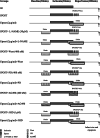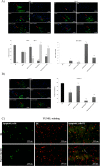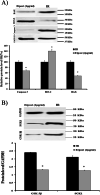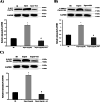Potentilla reptans L. postconditioning protects reperfusion injury via the RISK/SAFE pathways in an isolated rat heart
- PMID: 34823510
- PMCID: PMC8620719
- DOI: 10.1186/s12906-021-03456-2
Potentilla reptans L. postconditioning protects reperfusion injury via the RISK/SAFE pathways in an isolated rat heart
Abstract
Background: Our previous study indicated that Potentilla reptans root has a preconditioning effect by its antioxidant and anti-apoptotic effects in an isolated rat heart ischemia/reperfusion (IR) model. In the present study, we investigated the post-conditioning cardio-protective effects of Potentilla reptans and its active substances.
Methods: The ethyl acetate fraction of P. reptans root (Et) was subjected to an IR model under 30 min of ischemia and 100 min of reperfusion. To investigate the postconditioning effect, Et was perfused for 15 min at the early phase of reperfusion. RISK/SAFE pathway inhibitors, 5HD and L-NAME, were applied individually 10 min before the ischemia, either alone or in combination with Et during the early reperfusion phase. The hemodynamic factors and ventricular arrhythmia were calculated during the reperfusion. Oxidative stress, apoptosis markers, GSK-3β and SGK1 proteins were assessed at the end of experiments.
Results: Et postconditioning (Etpost) significantly reduced the infarct size, arrhythmia score, ventricular fibrillation incidence, and enhanced the hemodynamic parameters by decreasing the MDA level and increasing expression of Nrf2, SOD and CAT activities. Meanwhile, Etpost increased the BCl-2/BAX ratio and decreased Caspase-3 expression. The cardioprotective effect of Etpost was abrogated by L-NAME, Wortmannin (a PI3K/Akt inhibitor), and AG490 (a JAK/STAT3 inhibitor). Finally, Etpost reduced the expression of GSK-3β and SGK1 proteins pertaining to the IR group.
Conclusion: P. reptans reveals the post-conditioning effects via the Nrf2 pathway, NO release, and the RISK/SAFE pathway. Also, Etpost decreased apoptotic indexes by inhibiting GSK-3β and SGK1 expressions. Hence, our data suggest that Etpost can be a suitable natural candidate to protect cardiomyocytes during reperfusion injury.
Keywords: Anti-apoptotic; Antioxidant; GSK-3β; Ischemia/reperfusion; NO; Postconditioning; Potentilla reptans root; SGK1.
© 2021. The Author(s).
Conflict of interest statement
We wish to confirm that there are no known conflicts of interest associated with this publication and there has been no significant financial support for this work that could have influenced its outcome.
Figures







Similar articles
-
Cardioprotective and anti-apoptotic effects of Potentilla reptans L. root via Nrf2 pathway in an isolated rat heart ischemia/reperfusion model.Life Sci. 2018 Dec 15;215:216-226. doi: 10.1016/j.lfs.2018.11.021. Epub 2018 Nov 10. Life Sci. 2018. PMID: 30419282
-
Neuroprotective effect of Potentilla reptans L. root in the rat brain global ischemia/reperfusion model.Arch Pharm (Weinheim). 2023 Nov;356(11):e2300363. doi: 10.1002/ardp.202300363. Epub 2023 Aug 29. Arch Pharm (Weinheim). 2023. PMID: 37642540
-
The SAFE pathway is involved in the postconditioning mechanism of oxytocin in isolated rat heart.Peptides. 2019 Jan;111:142-151. doi: 10.1016/j.peptides.2018.04.002. Epub 2018 Apr 7. Peptides. 2019. PMID: 29635063
-
Six new triterpenoids from the root of Potentilla reptans and their cardioprotective effects in silico.Nat Prod Res. 2022 May;36(10):2504-2512. doi: 10.1080/14786419.2021.1912043. Epub 2021 Apr 19. Nat Prod Res. 2022. PMID: 33866888
-
Remifentanil Preconditioning Reduces Postischemic Myocardial Infarction and Improves Left Ventricular Performance via Activation of the Janus Activated Kinase-2/Signal Transducers and Activators of Transcription-3 Signal Pathway and Subsequent Inhibition of Glycogen Synthase Kinase-3β in Rats.Crit Care Med. 2016 Mar;44(3):e131-45. doi: 10.1097/CCM.0000000000001350. Crit Care Med. 2016. PMID: 26468894
Cited by
-
Potentilla reptans L. preconditioning regulates H19 and MIAT long noncoding RNAs in H9C2 myoblasts Ischemia/Reperfusion model.BMC Complement Med Ther. 2023 Jul 31;23(1):272. doi: 10.1186/s12906-023-04071-z. BMC Complement Med Ther. 2023. PMID: 37525174 Free PMC article.
-
Prediction of COVID-19 manipulation by selective ACE inhibitory compounds of Potentilla reptant root: In silico study and ADMET profile.Arab J Chem. 2022 Jul;15(7):103942. doi: 10.1016/j.arabjc.2022.103942. Epub 2022 Apr 27. Arab J Chem. 2022. PMID: 35502159 Free PMC article.
References
MeSH terms
Substances
LinkOut - more resources
Full Text Sources
Research Materials
Miscellaneous

